The Midland and North Leinster Group
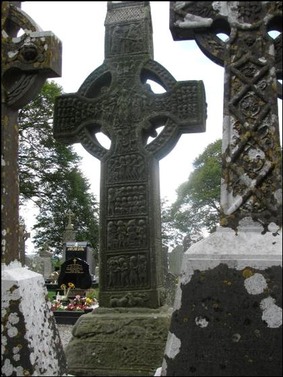
Overview
In general, there are two factors that might indicate a date for the erection of a particular cross. The first is the presence of an inscription bearing a name that can be located in the timeline of history. As many crosses either do not have inscriptions or have only partially discernable inscriptions this method of dating is at best limited to a small group of crosses. Another limitation of inscriptions is that a particular name may refer to more than one individual in the historic record.
The second method of dating a High Cross involves an analysis of the iconography of the cross. This is the field of the art historian and involves comparison of themes and artistic style with art from the mainland Europe and placing the piece in its historic context.
Above is the Cross of Muirdach, Monasterboice, County Louth, east face. It is one of the Midland and North Leinster Group.
To keep this month’s feature relatively brief I have chosen to rely almost completely on the work of Peter Harbison and to limit our exploration to one group of crosses, identified by Harbison as The Midlands and North Leinster group. (Harbison 1992, p 367 ff)
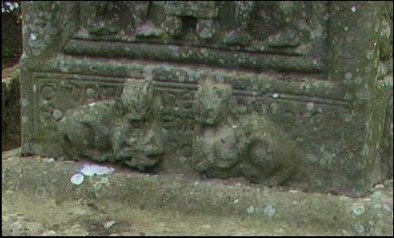
Inscriptions
The Cross of Muiredach [right] has an inscription on the lowest part of the shaft on the west face. The inscription, reproduced below, is carved around the figures of two cats. It is the only cross in the Midlands and North Leinster group to have a complete name in the inscription. The name is Muiredach. This is still not decisive for dating purposes, however. We know of two Muiredachs who were abbot at Monasterboice. One died in 844 and the other in 922. As Peter Harbison points out, there could, of course, be another Muiredach we don’t know about. (Harbison 1992, p 367) Still, the inscription, if properly understood to refer to one of these two abbots narrows the probable dating to a period of about 100 years.
OR DO MUIREDACH LAS NDERN(A)D (I)
CRO(SSA)
Prayer for Muiredach who had the cross erected
Hints from the inscriptions on the crosses at Durrow and the Scripture Cross at Clonmacnois tend to confirm that there are two likely periods for the erection of these crosses — “one in the second and third quarters of the ninth century, and the other in the first half of the tenth.” (Harbison 1992, p 368)
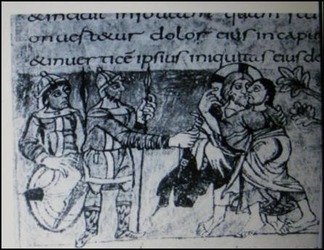
Iconography
One important step in attempting to date the High Crosses through the use of iconography is to seek parallels from the continent. Harbison believes the best sources for these comparisons come from “frescoes, mosaics, manuscripts and metalwork.” (Harbison 1992, p 369)
For example, the illustration [left] is an image of the Kiss of Judas on the night of Jesus’ betrayal. It is copied from Harbison 1992, vol. 3, figure 860. The image is from the Stuttgart Psalter, folio 8 recto dated to the late 820’s. This image is seen as comparable to the image of the Kiss of Judas on the Tall Cross at Monasterboice, the west face, the south arm (below left)
The same scene, with a somewhat different composition can be seen on the south base of the Cross of the Scriptures.at Clonmacnois (below center). This Harbison sees as comparable to the lower scene in the image (below right) copied from Harbison 1992, vol. 3, figure 861. This is from the Sacramentary of Drogo folio 44 verso done between 830 and 855. the upper scene in the initial letter “D” is a representation of the Lord’s Supper. In both cases there are a number of soldiers.
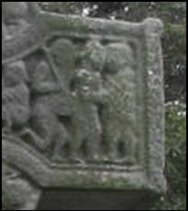
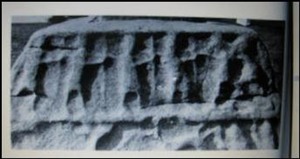
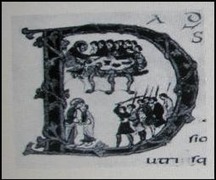
Above left: Tall Cross, Monasterboice, west face, south arm; center: Cross of the Scriptures, Clonmacnois, south base; [Photo from Harbison 1992], right: Sacramentary of Drogo, folio 44 verso, ca 830-855.CE. [Photo from Harbison 1992].
Historical Context
While the theological arguments are not immediately relevant to the dating of High Crosses, for much of the 8th and the first half of the 9th centuries there was a movement in the church to restrict the use of biblical images or the images of saints. The fear was that people were worshiping the images and not God. There were two main periods of this so-called Iconoclastic Controversy: 730-787 and 313-843. (McGinn, p 388)
This is relevant to the dating of the crosses because at the Council of Paris in 825, a council of the whole church, the restriction on the use of images was loosened. After 877 and the death of Charles the Bald, Holy Roman emperor, the use of biblical representations almost disappears for about 100 years. However, between these dates Louis the Pious, Holy Roman emperor 813-840 was friendly to the use of biblical images in art. This strongly suggests that the Midlands and North Leinster group of crosses were in the process of development during the second and third quarters of the 9th century.
An additional factor in dating the crosses to this period is the writing of the theologian Paschasius Radbertus. Between 831 and 833 he wrote an influential work onThe Body and Blood of the Lord. Which, in an interesting way, brings us back to the crosses of the Midlands and Northern Leinster group Harbison believes the Broken Cross at Kells may have been strongly influenced by the theology of Radbertus.
Kells, Co Meath, Broken Cross
In discussing the Broken Cross at Kells [below left west face, below right east face], Harbison makes a strong claim for a connection between the writings of Paschasius Radbertus and the images found on this cross. Passages of scripture Radbertus refers to in his book The Body and Blood of the Lord “can be seen to be so close to the selection of scenes on the Broken Cross at Kells that it could be claimed that the Kells cross is a veritable illustration of Paschasius’ treatise, which stresses so strongly the connection between baptism and the Eucharist.” (Harbison 1992, p 336)

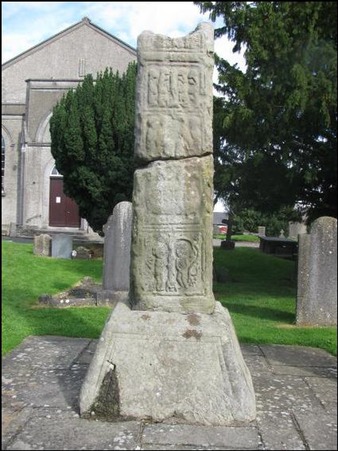
If Harbison’s assertion is correct, it creates another link between the second and third quarters of the 9th century and the development of the High Crosses of this group.
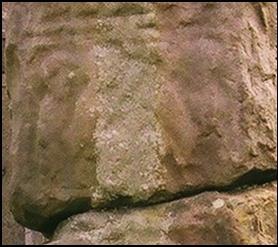
Here is some of the evidence Harbison cites. On the west face of the cross, which contains scenes from the Hebrew scriptures there is an image of the Nile River being turned to blood [left]. The text is found in Exodus 7:14-25. From left to right Moses, Aaron with the staff of Moses, Pharaoh holding a rod with at least one guard behind him. In the lower center are the heads of two of Pharaoh’s servants. (Harbison, 1992, p 103)
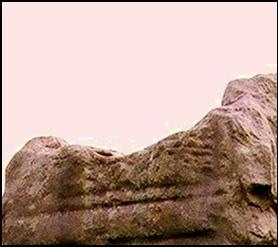
There is also an image of the Hebrew people Crossing the Red Sea [right]. This text comes from Exodus chapter 14. At the bottom of this broken panel are waves, presumably the Red Sea. Harbison discerns legs in the water at the center and left. Interpret this as the Egyptians being drowned as the Hebrews have reached the other side of the sea. (Harbison 1992, p 103) The first can easily be interpreted as a sign in Hebrew scriptures of the wine of Eucharist becoming the blood of Christ. The second can just as easily be interpreted as a sign in the Hebrew scriptures of baptism, the people passing through the waters and in essence becoming a new people.
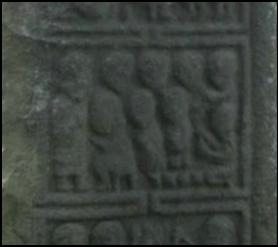
On the east face of the cross there is an image of the Wedding at Cana, from the Christian scriptures [left]. The text telling the story of the Wedding at Cana can be found in John 2:1-11. Jesus on the left faces the master of the feast who is seated. Behind the master are three or four servants, one of whom is pouring water into the jars at the bottom. Three guests look on. (Harbison, 1992, p 101) Here we have a miracle of water that becomes wine. This has been interpreted as a Eucharistic image.
References Cited:
Harbison, Peter; The High Crosses of Ireland: An Iconographical and Photographic Survey, Dr. Rudolf Habelt GMBH, Bonn, 1992. Volume 1: Text, Volume 2: Photographic Survey; Volume 3: Illustrations of Comparative Iconography.
McGinn, Bernard; Meyendorff, John and Leclercq, John, Christian Spirituality: Origins to the Twelfth Century,Crossroad, New York, 1985.